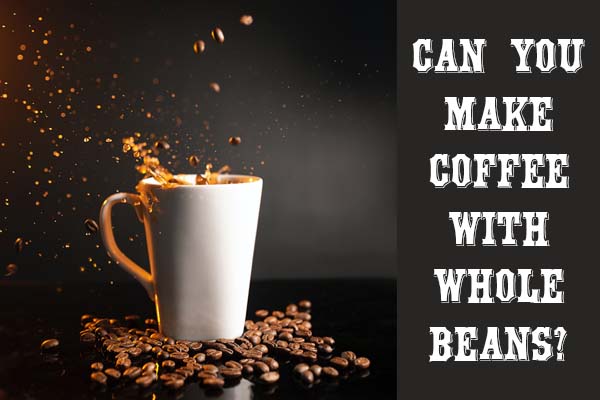Chances are that every cup of coffee you’ve had comes from ground coffee beans. But what do you do if you accidentally bought whole coffee beans and you don’t have a grinder? Or maybe your grinder stopped working.
Can you make coffee with whole beans?
Yes, you can make coffee with whole coffee beans. And brewing with whole beans may actually improve the flavor of the coffee because grinding can produce heat which can damage the bean. Also, with different grind sizes the brewing can extract a different amount of flavor from the bean also impacting the flavor.
How to Make coffee with Whole Beans
Here’s What You’ll Need:
- Whole Bean Coffee
- Water
- A small pot such as a sauce pot
- One pint mason jar
- Tongs or oven mitts
- Straining spoon – this is optional but makes it easier
- Coffee cup
In a previous article we said that you shouldn’t drink hot coffee out of a mason jar. But since mason jars are normally meant for canning foods it is normal to bring the mason jar up to temperature at the same speed water will boil on your stove. The key here is that it’s a gradual increase in temperature which avoids the mason jar shaking due to thermal shock.
Step 1
Add your whole coffee beans to the mason jar following a coffee to water ratio for drip coffee machines. The rule of thumb for drip coffee is 2 tablespoons of coffee beans to 6 ounces of water. I would add 6 tablespoons for a 16 to 18 ounce coffee. Mason jars can hold up to 32 ounces of liquid so your capacity should be 10 tablespoons of of coffee for 30 ounces of water.
Step 2
Add the appropriate amount of water to your mason jar to the amount of coffee beans you added. Note that the coffee beans will float in the water and this is normal.
Step 3
Place your mason jar inside the sauce pot and fill the pot with water. The level of water in the pot should match the level of water in the mason jar.
Step 4
Place the pot of water with the mason jar on the stove and heat the stovetop at 50% heat. Adjusting the heat as necessary the pot of water should get to a slow simmer. Simmer on the stove for 1 hour.
Step 5
When the hour is up remove the pot from the heat and remember to turn your stove off. With the tongs or oven mitts I find it’s easier to remove the mason jar from the pot of water and place it on a trivet or something flat and heat safe. I also like to empty the pot of water since I don’t like hot water just sitting around
Once that is done, again using tongs or oven mitts, pour the coffee from the mason jar into your coffee cup. Try not to get beans in your mug, but don’t really worry about beans getting in the coffee right now because you can remove them with a straining spoon. The main thing is to safely pour the coffee into your mug.
Now you’re ready to drink it black or add your coffee creamer of choice to enjoy your cup of coffee.
Why Does Brewing Whole Bean Coffee Take So Long?
Well, you now know you can make coffee with whole beans but you probably noticed it takes an hour. That’s a long time! But there are reasons it takes so long.
Whoever decided all those years ago that grinding coffee beans was a good idea was really onto something. It’s a much quicker process. By grinding the coffee beans the hot water is able to come in contact with more of a coffee beans surface area. This allows for a quicker extraction of the coffee beans flavor.
So when you’re brewing whole beans without grinding there’s less surface area to extract the coffee flavors from which makes for a slower brewed coffee.
Since you’re spending the time to make this coffee you also might want to consider making a full batch and storing the leftover coffee in the refrigerator or freezer.
Benefits of Making Coffee with Whole Beans
Grinding coffee beans is now common, but it does have some drawbacks. There are two main problems with grinding that can impact the taste of your coffee.
The first problem is that grinders, especially blade grinders and entry level grinders, can grind the coffee to different sizes. This impacts the flavor because as the water passes through the coffee beans the water is extracting the coffee of each ground bean at different rates. More often than not this can lead to coffee that is much weaker than you anticipated.
Lastly, the heat from a grinder can also impact the flavor of your coffee. Usually, the heat transferred into the bean during grinding can give off a burnt flavor to your coffee. This is not a good sign and can make a good coffee taste bad.
Coffee beans also deteriorate after grinding. The heat from the grinder begins the process of stripping the bean of their natural oils, and after a few minutes air can help to quickly start doing the rest.
Final Thoughts
Can you make coffee with whole beans? Absolutely! It takes a little bit of time to do, but if you have the time the end result is worth it if you need your coffee. So if you accidentally bought whole coffee beans and don’t know what to do with them now you have a solution.

